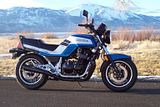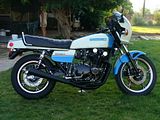Here is how it started.
From Tone:
As some of you know i worked on a straightening jig in an accident repair shop for a while & can tell you the accepable misalignment can be up to 4mm on some models as stock
 we "straightened" quite a few brand new frames for racers to bring them within 1mm of alignment or less & this is what i always aim for on my own bikes
we "straightened" quite a few brand new frames for racers to bring them within 1mm of alignment or less & this is what i always aim for on my own bikes Although this is the ideal, on a bike made up from a number of different parts that were never supposed to fit together the ideal is sometimes not acheivable due to the many variables involved
As posplar says a small misalignment can be tuned out by ajusting the wheel slightly more on one side than the other, the chain will allow you to do this by around 1mm without adverse effects on chain or sprocket life, although it is always better to avoid this if possible
When checking the wheel alignment do not use the ajusters at all ! leave them completely slack & push the wheel all the way forward within the slots & nip it up, the reason for this is that the marks on the ajusters are notoriously poor & the wheel will not be straight if you use them & the front edge of the ajuster slots is usually a fairly accurate place to start your measurements from while with the rear it is not always the case
summary .... 4mm of misalignment is just about acceptable but personally i wouldnt be happy with that
1mm or less is the ideal but not always acheivable
2mm to 2.5mm is the most misalignment you should be aiming for in my opinion & if that is not acheivable you did something wrong somewhere along the line
Hope it helps tone

Some pictures of doing a rear wheel to front wheel alighnment doing the string method.
Wheel alighnment using the sting method. I had a thin 600 lbs test kite line so it worked well.
I used this setup to keep the lines tight, the 30 lbs black box was propped up on a wooden block to keep the lines tight .
Quick check on chain alignment. Put 6 ft level against the tire and measured how much lateral offset there was the length of the chain. Looks like less than a link plate width. By measuring left and right forward and backward (4 equal measurements on the disks) confirms the wheels are aligned. Set the rear chain tension, then adjust the right hand side to make all 4 equal.
One last simple thing is to check the chain alignment with the wheel. I used a level below the chain and checked the alignment over the length of the chain. The level rests on the tire but for a chain it is close enough.
.png)
.png)






Comment